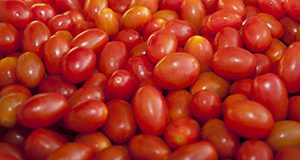Abstract
Tomatoes are one of the world's most consumed vegetable crops. In the United States, domestic production meets about 40% of the total domestic demand for fresh-market tomatoes, with the rest of the demand met by imports, mostly from Mexico and Canada. Since 2000, however, fresh tomato production in the United States has exhibited a steady declining trend. One major reason is the increased competition from Mexico. This 4-page fact sheet written by Zhengfei guan, Trina Biswas, and Feng Wu and published by the UF/IFAS Food and Resource Economics Department argues for US government measures to help the domestic tomato industry resolve labor shortages and encourage research and development of labor-saving technologies such as mechanical harvesting to make the US tomato industry more competitive and sustainable.
http://edis.ifas.ufl.edu/fe1027
References
CIA (Central Intelligence Agency). 2017. The World Factbook, Field Listing: Exports - Commodities. CIA, Washington, DC. https://www.cia.gov/library/publications/the-world-factbook/fields/2049.html
Diario Oficial, Quinta Sección, Secretaria de Agricultura, Ganadería, Desarrollo Rural, Pesca y Alimentacion (SAGARPA), 31 de Diciembre de 2010.
FAO (Food and Agriculture Organization of the United Nations). 2017. FAOSTAT Database. http://faostat3.fao.org/
US-DOC (United States Department of Commerce). 2017. DOC website. https://www.commerce.gov/.
USDA-AMS (United States Department of Agriculture, Agricultural Marketing Service). 2017. Fruits and Vegetables Market News. USDA-AMS, Washington, DC. http://www.ams.usda.gov/market-news/fruits-vegetables
USDA-AMS (United States Department of Agriculture, Agricultural Marketing Service). 2017. Tomatoes. USDA-AMS, Washington, DC. http://www.agmrc.org/commodities-products/vegetables/tomatoes
USDA-ERS (United States Department of Agriculture, Economic Research Service). 2017. Tomatoes. USDA-ERS, Washington, DC. https://www.ers.usda.gov/topics/crops/vegetables-pulses/tomatoes.aspx
USDA-FAS (United States Department of Agriculture, Foreign Agricultural Service). 2013. Tomato Suspension Agreement Key to Production and Trade Forecasts (GATS). USDA-FAS, Washington, DC. https://gain.fas.usda.gov/Recent%20GAIN%20Publications/Tomato%20Annual_Mexico%20City_Mexico_5-31-2013.pdf
USDA-NASS (United States Department of Agriculture, National Agricultural Statistics Service). 2016. Data and Statistics. USDA-NASS, Washington, DC. https://www.nass.usda.gov/Data_and_Statistics/index.php
Victoria, N.G., O.M.C. van der Valk, and A. Elings. 2011. Mexican Protected Horticulture: Production and Market of Mexican Protected Horticulture Described and Analysed (No. 1126). Wageningen UR Greenhouse Horticulture/LEI, Wageningen, The Netherlands.
Wu, F., Z. Guan, and M. Garcia-Nazariega. 2017. Comparison of Labor Costs between Florida and Mexican Strawberry Industries. FE1023. Gainesville, FL: University of Florida, Institute of Food and Agricultural Sciences. http://edis.ifas.ufl.edu/fe1023.
Wu, F., Z. Guan, and D.H. Suh. 2018. "The Effects of Tomato Suspension Agreements on Market Price Dynamics and Farm Revenue." Applied Economic Perspectives and Policy. Forthcoming. https://doi.org/10.1093/aepp/ppx029 https://doi.org/10.1093/aepp/ppx029
Zhu, M., Z. Guan, and F. Wu. 2013. "An Overview of the US Tomato Industry." 2013 Tomato Institute Proceedings.
Unless otherwise specified, articles published in the EDIS journal after January 1, 2024 are licensed under a Creative Commons Attribution-NonCommercial-NoDerivs 4.0 International (CC BY-NC-ND 4.0) license.

